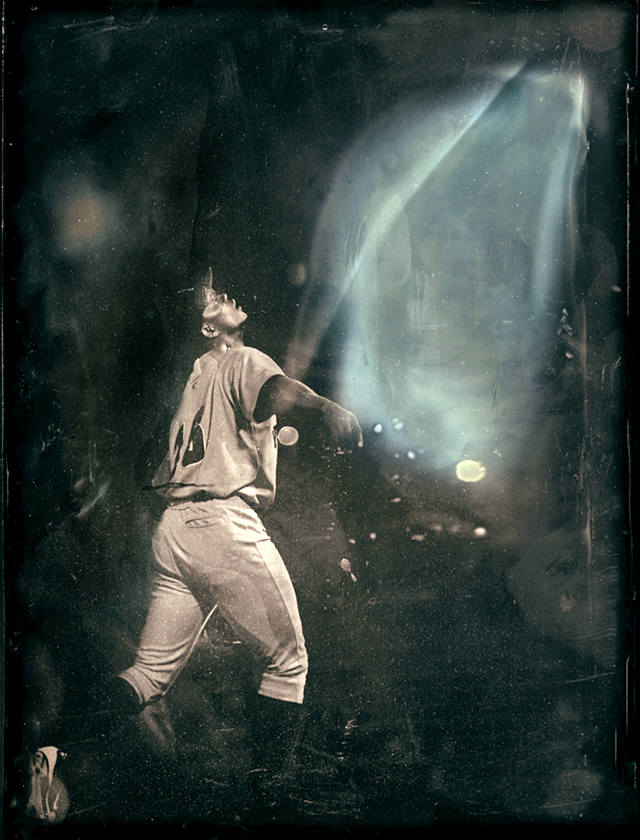Tucked away in the tree-lined hills of Berkeley, stationed among a compound of wood cottages, is Tabitha Soren’s darkroom: a converted garage that’s so cramped it would give anyone who’s claustrophobic the heebie jeebies. Inside, photo equipment and boxes of prints are piled onto shelves, marked with labels like “Billy Beane” and “BLANTON.” And on the day I visit, there are so many pictures of baseball players on display, one might think Soren was a fanatic. (She is not.)
She was once a rabid music fan; as she puts it, she used to be able to rattle off facts like the name of the newest keyboardist in Yes or the bassist for ACDC on command. That’s why she fit in so well as a reporter and anchor on MTV News, she says. But inside the darkroom, only a short stack of CDs from bands like the Alanis Morrisette, the Beastie Boys and David Bowie hint at her first career, which had her interviewing rock stars and politicians in front of millions of Gen X-ers and Y-ers for almost ten years.

“The MTV thing is complicated. Nobody in a second career wants to be defined solely by their first career,” Soren says. “But in my case, I wouldn’t be taking pictures if I hadn’t learned what I learned from making television.”
She gave up her MTV job in 1997 for a fellowship at Stanford University. There, she was allowed to take any classes she wanted, and she found herself spending more and more time in the art history and studio art departments. Burned out on her life in front of the camera, she realized she wanted to be behind it.
“I fell in love with something else,” Soren says. “After doing television since I was 18 years old, I wanted to do something new and live in California.”

In 2003 her husband, author Michael Lewis, began covering the Oakland Athletics, gathering research for what would become his bestselling book Moneyball. Soren, who had begun her editorial photography career by then, was with him when the team’s rookie class began spring training. Though she’s not a fan of baseball, when she saw the hope in the eyes of the 21 players vying to join the A’s, she committed herself to documenting their careers.
“I thought, ‘Wow, wouldn’t this be great to shoot their picture every year and see how their faces change, because they can’t remain this hopeful,'” Soren says.
Over the next 13 years, she traveled all over the United States, spending hours upon hours at minor league fields. She was with them until the end, watching as they all gradually dropped out of the game.
That is, all except for pitcher Joe Blanton. Blanton, drafted by the A’s in 2002, would go on to have a successful career pitching for the Philadelphia Phillies and the Los Angeles Dodgers before retiring in 2014. When Soren began exhibiting the series under the title Fantasy Life, Blanton was happily retired, owner of a vineyard in Calistoga. But he only stay retired for year — by early 2015, he signed a minor league contract with the Kansas City Royals. A couple of trades later, he’s playing with the Dodgers again.
“I remember being in a gym somewhere where I was giving an artist’s talk, and I look up and there he is, pitching in a major league game when I envisioned him squeezing grapes in his vineyard,” Soren said. “Somebody should’ve called me because I had been doing all this press saying that he was one of my retirees.”

The majority of the photographs in Fantasy Life are tintypes — unique prints made by exposing an image onto the emulsion over a thin sheet of metal. Each shot requires an exposure of a few seconds, and the process of developing the images is an arduous one.
“I had cuts all over my hands, there’s emulsion all over the place, I have boxes and boxes of ruined ones that are just pointless, and they’re heavy, and it’s just hard to get a good image,” Soren says. “I used up my patience doing those tintypes.”
But what Soren achieved with the old fashioned approach is a new perspective on the sport, one that focuses on the art within each player and strips away all the baggage of baseball. This effect is heightened by the imperfections in the tintypes — it’s practically impossible to develop a plate without any mistakes. The bubbles, strange colors and unique textures of Soren’s photographs only add to the fantasy portrayed within them.
The format also accentuates the age old story Soren aims to tell, one of Americans starting their lives and pursuing their dreams. It’s a story that especially applies to California, where people like Soren and Blanton come to restart their lives.
“This is the land of second chances. I feel like photography has been my second act; art has given me another chance at a career,” Soren says. “In baseball, it’s very unusual for a veteran to come back and impress anyone, and Joe Blanton is definitely doing that.”
“If that’s not the California dream, I don’t know what is.”
Photos from Soren’s Fantasy Life are part of the group exhibit Safe At Home, on view at the Bedford Gallery in Walnut Creek through June 12.